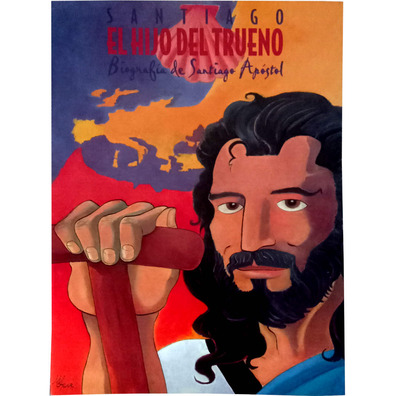Comic "Santiago, the son of thunder"
0,75€
Taxes includedCatholic product in stock. Products ready to be shipped. You can check the approximate delivery time during the purchase process.
Comic Santiago Apóstol, the son of thunder
- This comic tells us, from the years after the death of Jesus, how his disciples faced the task that their teacher had entrusted to them: "You will be my witnesses to the ends of the earth.
- Santiago Bar Zebedeo, Santiago Apostol. lived a great adventure carrying this message to the ends of the Earth (Finisterrae for the Romans).
- Santiago Apóstol, transmitting the message of Jesus, forever changed the life of the small communities settled in those lands. Over the centuries, it would completely transform the culture of the entire European continent.
- Santiago Apóstol comic with 32 pages
- Edited by the Delegation of Pilgrimages of the Archbishopric of Santiago.
The life of St. James the Apostle
The origins of Santiago Apóstol, the son of Thunder
The comic is the story that gave rise to the Camino de Santiago, the pilgrimage and with it the birth of Europe as we know it today.
The family of Santiago Apóstol was from a village called Yafía, near Nazareth.
The Apostle Santiago was fishing in the Sea of Tiberias when Jesus began his preaching in Galilee.
The call of Jesus and the response of James the Apostle and Saint John the Evangelist
Two of these twelve Apostles were the brothers Santiago Apóstol and San Juan Evangelista, dedicated to fishing in the Sea of Galilee or Tiberias with Zebedeo, their father. Jesus invited them to follow him (Mk. 1, 19) and they, together with Saint Peter, were part of Jesus' most intimate group: (Cf. Lk. 9,28; Mk. 5,37; Mt. 26,37).
The character of Santiago Apóstol
The Gospel highlights the strong temperament of the Apostle James. Thus, Santiago with his brother Juan, asked for fire from heaven for the Samaritans (Lk. 9,54); and to have the first positions (Mt. 20,21); Jesus called them Boanerges: Sons of Thunder (Mk. 3, 17)
The decision of James after the death of Jesus
Jesus Christ had told the Apostles: You will be my witnesses in Jerusalem, in Judea, in Galilee and to the end of the earth (Acts 1, 8). Where will Santiago Apóstol go to fulfill the word of Jesus?
He chooses for himself the most difficult task, he will travel to proclaim the word of Jesus to the farthest place known to man, the Apostle Santiago will travel to Finisterre.
From the death of Jesus to the martyrdom of the Apostle Santiago, beheaded by Herod Agrippa in the year 44 in Jerusalem (Acts 12, 2), about 10 or 12 years passed. More than enough time for him to preach the Gospel in Spain, written traditions from the early years and oral narratives from many places in the Iberian Peninsula speak of the preaching of the Apostle Santiago.
The Apostle Santiago with the youth
An open stance seems to fit with the temperament of Santiago Apóstol: implant the new message that Jesus brought, overcoming Jewish practices. For this he took with him some young men, the one known as Esteban, on his way to Finisterre. After long years of preaching, Santiago Apóstol decides to return with his Spanish disciples to Jerusalem
Saint James the Apostle suffers martyrdom for Jesus
Herodes Agripa initiates the persecution of the new group. It begins with those that stand out: Santiago Apóstol was the first to die, he was beheaded (Acts 12,2). Later Saint Peter also suffered repression, who was sent to jail (Acts 12,3 ss.). In these years of persecution, many faithful to the word of Jesus decide to flee from Jerusalem.
During their flight they spread the Good News of Jesus everywhere.
The disciples brought the body of Apostle Santiago to Galicia
Due to a rich tradition preserved in the town, we know that his disciples took his body to Iria-Compostela in a boat.
The Apostolic Men in Spain
In these first centuries, after the death of Santiago, some of his disciples, called Apostolic Men, later sent by Saint Peter from Rome, continued the evangelization in Spain, they are: Torcuato de Acci (Guadix), Indalecio (Bishop of Urci-Almería ), Ctesiphon of Vergi (Berja), Segundo of Abula (Ávila), Cecilio de Ilíberis (Elvira-Granada), Esiquio de Carcesa (Cáceres), Eufrasio de Ilitugi (Andujar)
The veneration of the tomb of the Apostle Santiago, at first would be only local
This local knowledge, God knows how many historical vicissitudes it will have endured, of fights, war, etc..., which would lead to times of abandonment and oblivion of the Tomb.
Time of resurgence of the veneration of Santiago Apóstol
The Providence of God has its time without annual periods. Thus, at the end of the 9th century, that tradition located in a small space expanded rapidly. The Bishop of Iria, Teodomino, and the King of Asturias, Alfonso II, convinced of the fact, announce it to the whole world through the Holy Empire inherited from Charlemagne.
Both are the main promoters of building a church in the place where they know that the remains of the Apostle Santiago rest. This Church soon becomes small, the news of the tomb of the Apostle Santiago continues to grow, as do the pilgrims who begin the path to see the tomb of Santiago the Apostle.
A new Church became essential and was built by King Alfonso III and Bishop Sisnando. It opens in the year 899.
The tomb of the Apostle Santiago will be glorious
That news spread throughout Europe. More and more pilgrims were taking the Camino a Santiago. More and more pilgrims received the favors of the Apostle Santiago: in the year 930 in the Reichenau Monastery, in southern Germany, near Lake Constance, the narration of a clergyman who recovered his sight on his pilgrimage to Santiago appears. And in 951, a document from the Albelda Monastery, Logroño, narrates the pilgrimage of the Bishop of Le Puy (France), called Gotescalco, who was returning from Santiago with a large retinue. These early written documents show that it should have been a well-known fact even then. It is believed that it is in these years when the Concha de Santiago begins to be used as a symbol of the pilgrims.
The great pilgrimage to the Sepulcher of the Apostle Santiago
Approaching the Tomb of the Apostle Santiago invited to connect with who was a direct witness of the saving acts of the Lord; go to the very roots of faith. The influx of pilgrims led the Popes to stimulate the pilgrimage with special graces. Thus, in 1122 Pope Calixto II, and Alexander III in 1179, granted in perpetuity the Jubilee of the Holy Year for the church of Santiago. Every time the day of Santiago Apóstol, July 25, fell on a Sunday, the Jacobean year would be celebrated, a year in which special gifts would be granted to pilgrims who visited the tomb of the Apostle Santiago. In this way numerous kings, holy men, men from all social sectors decided to visit the tomb of Santiago Apóstol.
Exhibition of the Tomb of Santiago Apóstol for veneration
The current Santiago Cathedral is the third building that was built on the tomb of the Apostle Santiago, which has always remained in the same place
In 1887, Archbishop D. Miguel Payá y Rico restructured the place where the Remains of the Apostle Santiago are located, under the main altar of the Cathedral. In addition, a scientific analysis was carried out, first diocesan approved by Pope Leo XIII, followed by a Roman process, with the study on the authenticity of the remains of the Apostle Santiago and his disciples Athanasius and Theodore.
After this study, the access to the Tomb of the Apostle Santiago was restructured; and the faithful, who had only been able to approach outside the ambulatory of the Cathedral of Santiago , were able, since then, to venerate the Tomb of the Apostle directly.
The Church invites pilgrimage to the Tomb of the Apostle Santiago
Pope Leo XIII wrote a Bull entitled Deus Omnipotens to the episcopate of the whole world, inviting them to make a pilgrimage to the Tomb of Santiago Apóstol whose authenticity had been proven.
From here, numerous Popes express the importance of making a pilgrimage to Santiago de Compostela. The Holy Years (Jacobean Years) the usual pilgrimages increase dramatically.
In 1982, in Santiago de Compostela, Pope John Paul II calls himself a pilgrim. And in 1989, he chairs the IV World Youth Meeting, with some 500,000 young people, coming from all over the world, in Monte del Gozo.
The Pilgrimage to the Tomb of the Apostle Santiago today
Every year almost as many pilgrims come as if it were a Holy Year. In the Holy Year of 1993, 99,436 pilgrims were registered who arrived on foot, bicycle or horse, making the Camino de Santiago. Always from a distance not less than 100 km. The number of pilgrims to Santiago promoted by Church institutions is estimated that year at four and a half million people.
But the pilgrimage to Santiago continues, and those who arrive with a penitential attitude, especially on foot, were in 1994: 15,863; in 1995: 19,821; in 1996: 23,218; in 1997: 25,179. The part of the pilgrims to Santiago come from pilgrimages organized by institutions.
In the Cathedral of Santiago there are pilgrims every day of the year; particularly numerous in the summer months. The experience of contact with them, manifests the great level of faith that provides a pilgrimage to this Tomb of the Apostle Santiago. And the Church invites pilgrims doing the Camino de Santiago with an attitude of faith.








